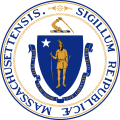| ||||||||||||||||||||||||||
| Turnout | 68.4% [1] | |||||||||||||||||||||||||
|---|---|---|---|---|---|---|---|---|---|---|---|---|---|---|---|---|---|---|---|---|---|---|---|---|---|---|
| ||||||||||||||||||||||||||
| ||||||||||||||||||||||||||
| ||||||||||||||||||||||||||
| Elections in Massachusetts |
|---|
 |
The 1964 United States presidential election in Massachusetts took place on November 3, 1964, as part of the 1964 United States presidential election, which was held throughout all 50 states and D.C. Voters chose 14 representatives, or electors to the Electoral College, who voted for president and vice president.
Contents
Massachusetts voted overwhelmingly for the Democratic nominee, incumbent President Lyndon B. Johnson of Texas, over the Republican nominee, Senator Barry Goldwater of Arizona. Johnson ran with Senator Hubert H. Humphrey of Minnesota, while Goldwater's running mate was Congressman William E. Miller of New York.
Johnson carried Massachusetts in a landslide, taking 76.19% of the vote to Goldwater's 23.44%, a Democratic victory margin of 52.75%. This made it the third-most Democratic state in the nation, after Rhode Island and Hawaii, and remains the strongest-ever Democratic showing in Massachusetts. [2] Even in the midst of the nationwide Democratic landslide of that year, Massachusetts still weighed in as 30% more Democratic than the national average. [2]
Massachusetts had been a Democratic-leaning state since 1928, but had voted Republican as recently as 1956, when Dwight Eisenhower won the state by 19 points. In 1960, Massachusetts native John F. Kennedy had carried the state with 60.22% of the vote, which up to that point was the strongest-ever Democratic showing in Massachusetts, but this record was quickly overtaken by Johnson in 1964.
The staunch conservative Barry Goldwater was widely seen in the liberal Northeastern United States as a right-wing extremist; [3] he had voted against the Civil Rights Act of 1964, and the Johnson campaign portrayed him as a warmonger who as president would provoke a nuclear war. [4] Thus, Goldwater performed especially weakly in liberal Northeastern states such as Massachusetts. Not only did Johnson win every Northeastern state—the first time that a Democratic presidential candidate had done so—but he won all of them with over 60% of the vote.
While Kennedy had won 60% in Massachusetts in 1960 mostly by garnering the ethnic Catholic vote, in 1964 the traditional Democratic coalition was joined by a mass defection of moderate Yankee Republicans who had voted for Eisenhower and Nixon but could not support Goldwater. [3] Consequently, the incumbent Johnson was able to sweep the state—and indeed Goldwater wrote off this state and neighboring Connecticut, Rhode Island, and New York, as well as New Jersey, Pennsylvania and Michigan, from the beginning of his presidential campaign, prior to Kennedy's assassination. [5]




